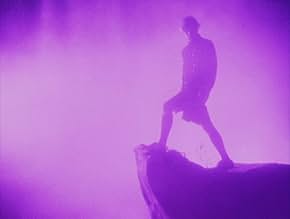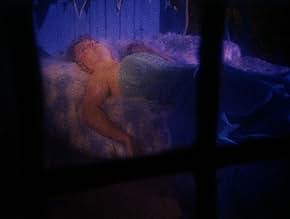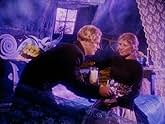The wary residents of a 19th century mountain village must tread carefully and speak softly lest they cause an avalanche. Sexual frenzies teem in this world of repression, setting off incest... Read allThe wary residents of a 19th century mountain village must tread carefully and speak softly lest they cause an avalanche. Sexual frenzies teem in this world of repression, setting off incestuous love triangles with deadly consequences.The wary residents of a 19th century mountain village must tread carefully and speak softly lest they cause an avalanche. Sexual frenzies teem in this world of repression, setting off incestuous love triangles with deadly consequences.
- Awards
- 1 win total
Andrea Von Wichert
- Townsperson
- (as Andrea Wichert)
Featured reviews
I love Guy Maddin's work and this is my favourite of his films. It's odd and unsettling and it sticks with you long after you've watched it.
It's definitely not the most accessible of his works, but I like it. It's been described as a "pro-repressionist" movie, but I don't think that's entirely accurate.
The people portrayed in the village are deeply repressed and one small push makes their whole stack of cards morals come tumbling down. It's tale of three brothers and their trials and tribulations.
Their father is deceased and one brother, Vince Rimmer as Franz, is an invalid confined to the attic, who can do little more than watch as his brothers are tempted and run amok.
First Brent Neale as Johann, then Kyle McColloch as Grigorss give in to their desires and forbidden longings with tragic consequences. Kyle McColloch is a Maddin regular and he shines here.
Engagements are broken, people have knife fights and their mother is seeking to re-marry.
It's definitely not the most accessible of his works, but I like it. It's been described as a "pro-repressionist" movie, but I don't think that's entirely accurate.
The people portrayed in the village are deeply repressed and one small push makes their whole stack of cards morals come tumbling down. It's tale of three brothers and their trials and tribulations.
Their father is deceased and one brother, Vince Rimmer as Franz, is an invalid confined to the attic, who can do little more than watch as his brothers are tempted and run amok.
First Brent Neale as Johann, then Kyle McColloch as Grigorss give in to their desires and forbidden longings with tragic consequences. Kyle McColloch is a Maddin regular and he shines here.
Engagements are broken, people have knife fights and their mother is seeking to re-marry.
Influenced by the German Expressionist films of the 1920s and filtered through the oddball sensibilities of writer/director Guy Maddin, Careful is a film like no other. Maddin appropriates silent cinema's monochrome aesthetic in multiple scenes but even when color is being used in a more traditional way he tends to fill the screen with garish brightness. The film has (melo)dramatic elements but is primarily comedic, albeit with a wink and a nudge subtlety almost altogether absent from silent film's heyday.
The bizarre plot of the film is centered on a repressed mountain community, particularly the brothers Johan and Grigors and their mother. The boys' father, who lost both his eyes in separate freak accidents, is long since dead and their older brother is locked in the attic where he silently watches. Johan and his younger brother spend most of their time in a strict school for butlers where they learn about dining etiquette and grooming. Johan becomes engaged to Klara, a local girl who lusts after her own father in spite of his clear favoritism toward his younger daughter, in spite of his own obsessive lust directed at his mother. Naturally, characters become involved in murder plots, duels, and suicide as they're too repressed and shut off to resolve their problems in a less dramatic fashion.
Thematically, Careful is too jumbled to have much coherence but like most Maddin films this is more about style than plot or meaning. Maddin's creative visual style is engaging enough on its own to make Careful a worthwhile film.
The bizarre plot of the film is centered on a repressed mountain community, particularly the brothers Johan and Grigors and their mother. The boys' father, who lost both his eyes in separate freak accidents, is long since dead and their older brother is locked in the attic where he silently watches. Johan and his younger brother spend most of their time in a strict school for butlers where they learn about dining etiquette and grooming. Johan becomes engaged to Klara, a local girl who lusts after her own father in spite of his clear favoritism toward his younger daughter, in spite of his own obsessive lust directed at his mother. Naturally, characters become involved in murder plots, duels, and suicide as they're too repressed and shut off to resolve their problems in a less dramatic fashion.
Thematically, Careful is too jumbled to have much coherence but like most Maddin films this is more about style than plot or meaning. Maddin's creative visual style is engaging enough on its own to make Careful a worthwhile film.
The USA Film Festival described this as Twin Peaks directed by Erich von Stroheim. Not a bad description. It's an uproarious satire, in the vein of YOUNG FRANKENSTEIN ... but the film often so beautifully duplicates the material it parodies that your breath is taken away. It's a little like reading a hysterical comic book, and finding original paintings by old masters salted throughout!
This brilliant Canadian film heavily borrows from the high-camp expressionism of German silent films and early talkies, especially the "mountain" films of Leni Riefenstahl. Anyone who's read FROM CALIGARI TO HITLER will recognize dozens of scenes in this film as near carbons of stills from the book. Perhaps more than any other films before or since, German silent cinema created compelling images that tap into universal race consciousness, portraying grainy, moving archetypal images all of us vaguely recognize from dreams or nightmares. Because of this, CAREFUL will often take your breath away with unexpected moments of quiet majesty and beauty. But there are plenty of laughs in between, (with "sick," 70's style National Lampoon-like humor). If you've never laughed at seeing an eye poked out, leave political correctness at the door and give this film a whirl!
The soundtrack if often deliberately scratchy or muffled, and in several scenes easter-egg like colors are used that resemble the early two-strip technicolor process. Ominous title cards are used to introduce scenes. This bizarre film is salted with unexpected dialogue like this: BOY: "My, aren't you the frisky one today." GIRL: "Even the reindeer are such, when Spring is coming!"
Enough of the aesthetics, what is the film supposedly about? The action takes place in the 19th century alpine village of Tolzbad, that is so precariously poised under constant threat of avalanche that villagers have learned to communicate only in whispers. Animals have had their vocal chords removed, and gramophones have lambs wool stuffed in the horn. Villagers keep time to the "sound" of silent instruments at a "concert." There are handful of soundproof ice caves where the villagers can frolic and shout, letting out their pent up, pagan passions. The film is clearly a biblical parable about repression. Jackie Burroughs does a brilliant bit part as the puritanical teacher, who closely resembles the Cloris Leachman role in YOUNG FRANKENSTEIN.
All of the characters display a surface naivete; actresses speak in the perky, breathless voices reminiscent of badly dubbed post-war European B films; "strapping" young sons still wear short pants'd school uniforms. The film quickly descends below the surface to show the village as a cauldron of incestuous flirtations, violent retaliation and explosive "family secrets." The plot follows an arc of forbidden loves and passions, leading to retribution on a biblical scale. What may appear to the modern audience as "cheap" special effects are actually loving recreations of how ghosts and visions were portrayed in silent and early talking German films. Many of the images are unforgettable, like the "trolley" cars pulled by oxen, or the mine workers wearing crowns of flickering candles. Uncoated lenses and back lit hair make some closeups resemble images from early Garbo or Dietrich films.
CAREFUL warrants multiple viewings. Watch it with a friend; this is definitely a film you'll want to dissect over several capuccinos.
This brilliant Canadian film heavily borrows from the high-camp expressionism of German silent films and early talkies, especially the "mountain" films of Leni Riefenstahl. Anyone who's read FROM CALIGARI TO HITLER will recognize dozens of scenes in this film as near carbons of stills from the book. Perhaps more than any other films before or since, German silent cinema created compelling images that tap into universal race consciousness, portraying grainy, moving archetypal images all of us vaguely recognize from dreams or nightmares. Because of this, CAREFUL will often take your breath away with unexpected moments of quiet majesty and beauty. But there are plenty of laughs in between, (with "sick," 70's style National Lampoon-like humor). If you've never laughed at seeing an eye poked out, leave political correctness at the door and give this film a whirl!
The soundtrack if often deliberately scratchy or muffled, and in several scenes easter-egg like colors are used that resemble the early two-strip technicolor process. Ominous title cards are used to introduce scenes. This bizarre film is salted with unexpected dialogue like this: BOY: "My, aren't you the frisky one today." GIRL: "Even the reindeer are such, when Spring is coming!"
Enough of the aesthetics, what is the film supposedly about? The action takes place in the 19th century alpine village of Tolzbad, that is so precariously poised under constant threat of avalanche that villagers have learned to communicate only in whispers. Animals have had their vocal chords removed, and gramophones have lambs wool stuffed in the horn. Villagers keep time to the "sound" of silent instruments at a "concert." There are handful of soundproof ice caves where the villagers can frolic and shout, letting out their pent up, pagan passions. The film is clearly a biblical parable about repression. Jackie Burroughs does a brilliant bit part as the puritanical teacher, who closely resembles the Cloris Leachman role in YOUNG FRANKENSTEIN.
All of the characters display a surface naivete; actresses speak in the perky, breathless voices reminiscent of badly dubbed post-war European B films; "strapping" young sons still wear short pants'd school uniforms. The film quickly descends below the surface to show the village as a cauldron of incestuous flirtations, violent retaliation and explosive "family secrets." The plot follows an arc of forbidden loves and passions, leading to retribution on a biblical scale. What may appear to the modern audience as "cheap" special effects are actually loving recreations of how ghosts and visions were portrayed in silent and early talking German films. Many of the images are unforgettable, like the "trolley" cars pulled by oxen, or the mine workers wearing crowns of flickering candles. Uncoated lenses and back lit hair make some closeups resemble images from early Garbo or Dietrich films.
CAREFUL warrants multiple viewings. Watch it with a friend; this is definitely a film you'll want to dissect over several capuccinos.
I recently watched the film, Careful, by Guy Maddin on television and found it to be very interesting indeed. The person introducing the film called Maddin a Canadian David Lynch and while both directors do have a certain flair for the unusual, I believe Lynch to be a surrealist while Maddin's style to be something else entirely. Granted, Careful is the only film of Maddin's I have seen except for excerpts and press for The Saddest Music in the World, but his style, at least in this film, is one of sentimentality and homage. I have seen plenty of German Expressionist films and Careful would seem to fit right into that mold. I myself have often toyed with the idea of producing a film in the Expressionist style if only for the exercise of it. Maddin has produced an Expressionist film in the year 1992 which flawlessly mimics the films of Ufa, Wiene, Murnau, and Lang from the early 20th century. Any viewer, even those versed in early Expressionism, who would happen across this film without any context would be forgiven for mistaking it to be an actual 80-year-old film, so true is Maddin's style, so exacting is his pacing. Full frame color tinting, sound stage shooting, post-produced soundtrack, rigid acting style, and obsolete directorial choices, combine to provide the viewer with a disturbing portrait of repression, duty, and mountain goats. This film is incredible!
If you are a fan of German Expressionism, then you will enjoy this modern homage to a beautiful and arresting style perceived and captured wonderfully by Guy Maddin. There is a ton of symbolism and exploration of the sexual taboos found in both the Oedipus and Cassandra complexes of Greek mythology while allowing for quite humorous character developments which certainly make the film that much more enjoyable than just an "art" film. Maddin's use of light and especially color adds to the classic expressionist model which gets a gorgeous injection of modern fare. While I can enjoy the notion of one reviewer calling this a cross between "The Wizard of Oz and Eraserhead", I definately saw this as a much more direct colorful homage to "Caligari" than anything Lynch-esque. There is not the mind-numbing mixture of light and sound which generates its own tension but rather a playful use of sets and characters which surmount to quite a comical time. That is not to say there is not a scene or two that would make a horror fan happy but they are very straight forward and even amusing.
Did you know
- TriviaRebecca Gibson's debut.
- ConnectionsFeatured in Guy Maddin: En attendant le crépuscule (1997)
- How long is Careful?Powered by Alexa
Details
Contribute to this page
Suggest an edit or add missing content

























